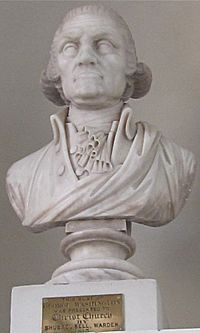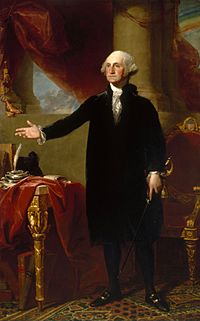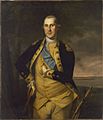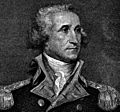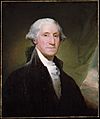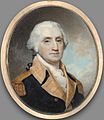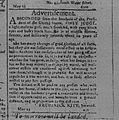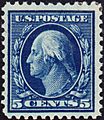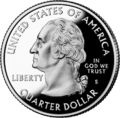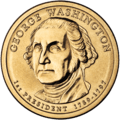George Washington facts for kids
Quick facts for kids
George Washington
|
|
|---|---|
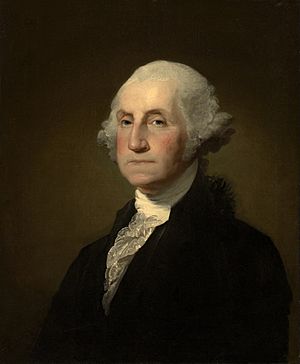 |
|
| 1st President of the United States | |
| In office April 30, 1789 – March 4, 1797 |
|
| Vice President | John Adams |
| Preceded by | Office established |
| Succeeded by | John Adams |
| 7th Senior Officer of the United States Army | |
| In office July 13, 1798 – December 14, 1799 |
|
| President | John Adams |
| Preceded by | James Wilkinson |
| Succeeded by | Alexander Hamilton |
| Commander-in-Chief of the Continental Army | |
| In office June 14, 1775 – December 23, 1783 |
|
| Appointed by | Continental Congress |
| Preceded by | Office established |
| Succeeded by | Henry Knox as Senior Officer |
| Delegate to the Continental Congress from Virginia |
|
| In office May 10, 1775 – June 15, 1775 |
|
| Preceded by | Office established |
| Succeeded by | Thomas Jefferson |
| Constituency | Second Continental Congress |
| In office September 5, 1774 – October 26, 1774 |
|
| Preceded by | Office established |
| Succeeded by | Office abolished |
| Constituency | First Continental Congress |
| Member of the Virginia House of Burgesses |
|
| In office May 18, 1761 – May 6, 1776 |
|
| Preceded by | Unknown |
| Succeeded by | Office abolished |
| Constituency | Fairfax County |
| In office July 24, 1758 – May 18, 1761 |
|
| Preceded by | Thomas Swearingen |
| Succeeded by | George Mercer |
| Constituency | Frederick County |
| Personal details | |
| Born | February 22, 1732 Popes Creek, Colony of Virginia, British America |
| Died | December 14, 1799 (aged 67) Mount Vernon, Virginia, U.S. |
| Political party | Independent |
| Spouse | |
| Children | John (adopted) Patsy (adopted) |
| Parents | Augustine Washington Mary Ball Washington |
| Residence | Mount Vernon |
| Awards | Congressional Gold Medal Thanks of Congress |
| Signature | |
| Military service | |
| Allegiance | |
| Branch/service | |
| Years of service | 1752–58 (Colonial forces) 1775–83 (Continental Army) 1798–99 (U.S. Army) |
| Rank | Colonel (Colonial forces) General and Commander-in-Chief (Continental Army) |
| Commands | Virginia Regiment Continental Army United States Army |
| Battles/wars | French and Indian War |
George Washington (February 22, 1732 – December 14, 1799) was a very important leader in American history. He was the first President of the United States from 1789 to 1797. Before that, he was the top commander of the Continental Army during the American Revolutionary War. He is known as one of the Founding Fathers of the United States.
Contents
Early Life and Family
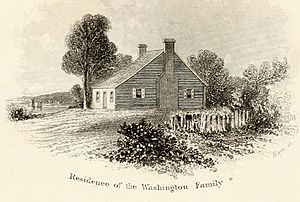
George Washington was born on February 22, 1732. His birthplace was Popes Creek in Westmoreland County, Virginia. He was the first of six children born to Augustine Washington and Mary Ball Washington. George also had four older half-siblings from his father's first marriage.
His family was wealthy and lived in Virginia. His father was a respected public figure. The family moved several times when George was young. When his father died in 1743, George inherited a farm called Ferry Farm and some people who were enslaved. His older half-brother, Lawrence, inherited another property and named it Mount Vernon.
George did not go to a formal school like his older brothers. However, he learned important skills at home. He studied mathematics, trigonometry, and land surveying. He was also very good at drawing and making maps.
Before the Revolutionary War
Washington became a farmer at his home, Mount Vernon. He also worked as a surveyor, measuring land for others. He always wanted to be a soldier. He joined the local army in Virginia, called the colonial militia.
He was sent to the "forks of the Ohio River" (now Pittsburgh) several times. His mission was to remove the French who were trying to control the area. He faced difficulties, and many of his men were killed. This conflict helped start the French and Indian War. This war later led to Britain joining the larger Seven Years' War. In 1758, Washington was chosen to be a part of Virginia's government.
In 1759, Washington married Martha Custis, a widow. They did not have any children together.
Leading the Revolution
Washington was chosen to represent Virginia at the Continental Congress. This group was formed by the Thirteen Colonies to respond to new laws from the British government. The Second Continental Congress then picked him to be the main general of the Continental Army. Washington led this army from 1775 until the war ended in 1783.
After losing the big Battle of Long Island, Washington led his troops in a daring move. On Christmas Day, 1776, he crossed the Delaware River. This surprise attack led to victories against German soldiers (called Hessians) at the Battle of Princeton and Trenton, New Jersey. Even though the British had more soldiers and supplies, Washington kept his army together. He won these important small battles.
Washington did not win every battle. But he always made sure the British could not completely destroy his army. With help from the French army and navy, Washington forced a British army to surrender at Yorktown, Virginia, in 1781. The Battle of Yorktown was the last major battle of the war. The war officially ended with the Treaty of Paris in 1783.
After the War
After the Revolutionary War, Washington was seen as a national hero. He was offered a powerful government position, almost like a dictatorship. But Washington surprised everyone by saying no. He left the army and went back to his home at Mount Vernon. He wanted the new country to have a strong government. However, he did not want to be a tyrant or lead that government himself.
Washington believed the country needed a new set of rules. So, he helped organize the Constitutional Convention in 1787. He was chosen to lead the meetings. The people at the convention wrote the Constitution of the United States. All the states approved it, and a new government was formed.
His Time as President
In 1789, George Washington was elected the first President of the United States. He ran without any competition. Washington did not belong to a political party. However, he agreed with some ideas of the Federalist Party. These ideas included having a strong national army and a national bank.
He was elected for a second term. After his second term, Washington decided not to run again. This was even though he was still very popular. His choice to serve only two terms set an important example. Almost every president after him followed this rule until Franklin D. Roosevelt in 1940.
In his farewell speech, Washington gave important advice. He warned the country not to split into political parties. He also advised against getting involved in wars outside the United States. Many Americans followed his advice to avoid foreign wars for over a hundred years. However, his advice about political parties was not followed. Parties were already starting to form when he gave his speech.
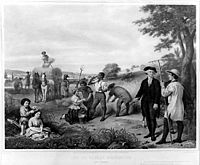
Retirement and Death
After his second term ended in 1797, Washington returned home to Mount Vernon in Virginia. He died two years later, on December 14, 1799. He was 67 years old and passed away from pneumonia.
Wealth and Property
George Washington owned a lot of farmland. On his land, he grew crops like tobacco, wheat, and vegetables. He also owned over 100 enslaved people. He stated in his will that they would be freed after his death. He did not have a lot of cash money and sometimes had to borrow money while he was President. When he died, his property and belongings were worth a lot of money, over $500,000.
His Famous Teeth
George Washington started losing his teeth when he was only 22. By the time he became President, he had only one tooth left. He eventually had that one pulled too. He kept it in a gold locket on his watch chain.
Many people think Washington had wooden teeth, but this is a common mistake. His false teeth were made from elk's teeth or ivory. He tried to clean them by soaking them in wine. This did not clean them. Instead, it stained the tiny cracks in the teeth, making them look like wood grain. When artists painted his portrait, they would put cotton under his lips. This made his mouth look fuller, as if he had teeth. This is why his mouth looks a bit puffy in the picture on the US $1 bill.
Interesting Facts About George Washington
- George Washington's actual birthday was 11 days earlier than it is now listed. This change happened when the colonies switched from the Gregorian calendar to the Julian calendar.
- He did not have a middle name.
- George powdered his own hair instead of wearing a wig.
- In 1976, George Washington was given the highest rank in the military: The General of the Armies of the United States.
- Some people believe George Washington may have died because a doctor tried to help him by taking too much blood from his body. This process is called bloodletting.
- He wrote between 18,000 and 20,000 letters in his lifetime. If you wrote one letter a day, it would take you 50-55 years to write that many!
- George Washington loved dogs.
- He was the only President to go into battle while serving as the President.
Images for kids
-
Lieutenant Colonel Washington holds night council at Fort Necessity
-
Washington the Soldier: Lieutenant Colonel Washington on horseback during the Battle of the Monongahela (oil, Reǵnier, 1834)
-
Colonel George Washington, by Charles Willson Peale, 1772
-
Martha Washington based on a 1757 portrait by John Wollaston
-
General Washington, Commander of the Continental Army by Charles Willson Peale (1776)
-
Washington Crossing the Delaware, Emanuel Leutze (1851)
-
The Passage of the Delaware, by Thomas Sully, 1819 (Museum of Fine Arts, Boston)
-
Washington Rallying the Troops at Monmouth, Emanuel Leutze (1851–1854)
-
French King Louis XVI allied with Washington and Patriot American colonists
-
Siege of Yorktown, Generals Washington and Rochambeau give last orders before the attack
-
General George Washington Resigning His Commission, by John Trumbull, 1824
-
Shays' Rebellion confirmed for Washington the need to overhaul the Articles of Confederation.
-
John Jay, negotiator of the Jay Treaty
-
Seneca chief Red Jacket was Washington's peace emissary with the Northwestern Confederacy.
-
USS Constitution: Commissioned and named by President Washington in 1794
-
Miniature of George Washington by Robert Field (1800)
-
George Washington's bookplate with the Coat of arms of the Washington family
-
Runaway advertisement for Oney Judge, enslaved servant in Washington's presidential household
-
Washington, the Constable by Gilbert Stuart (1797)
-
Washington Monument, Washington, D.C.
-
Washington–Franklin issue of 1917
-
Washington quarter dollar
-
George Washington Presidential one-dollar coin
-
Washington on the 1928 dollar bill
See also
 In Spanish: George Washington para niños
In Spanish: George Washington para niños


